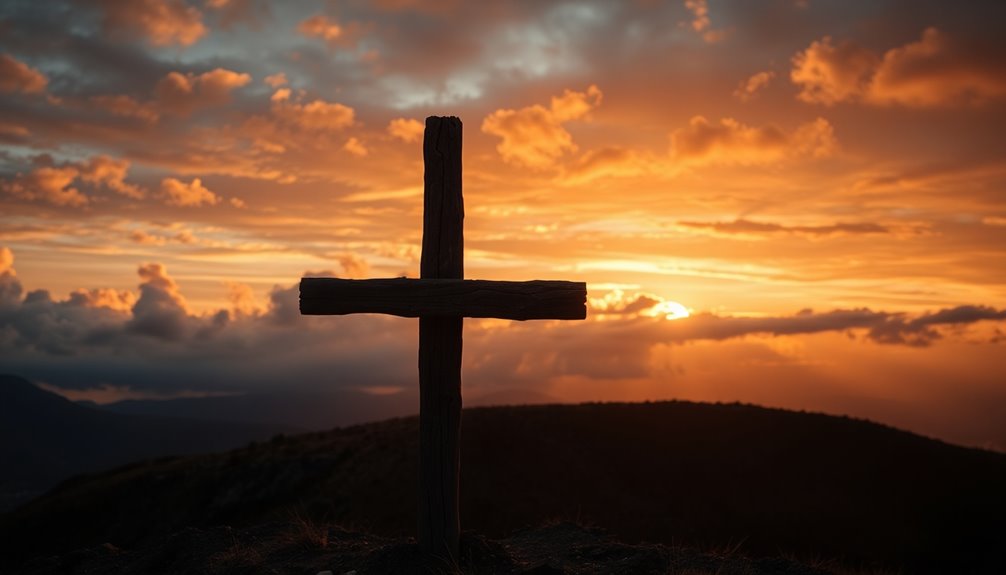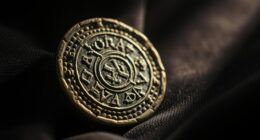Jesus died on Friday, April 3, AD 33. This day, known as the Day of Preparation, precedes the Jewish Sabbath and also aligns with Passover. In the Gospels, you'll find that His crucifixion started around noon and lasted until about 3 PM, mirroring the timing of the Passover lamb sacrifices. This significant event emphasizes Jesus as the ultimate sacrificial lamb, central to the themes of liberation and redemption. The story doesn't end here, though. There's much more to uncover about the events leading up to His crucifixion and their importance in the context of faith.
Key Takeaways
- Jesus was crucified on Friday, April 3, AD 33, known as Good Friday.
- The crucifixion occurred on the Day of Preparation preceding the Jewish Sabbath.
- Jesus died at approximately 3 PM, coinciding with the slaughter of the Passover lambs.
- The Last Supper, celebrated as a Passover meal, took place the night before the crucifixion.
- Discrepancies exist in Gospel accounts regarding the timing of the Last Supper and crucifixion.
Introduction
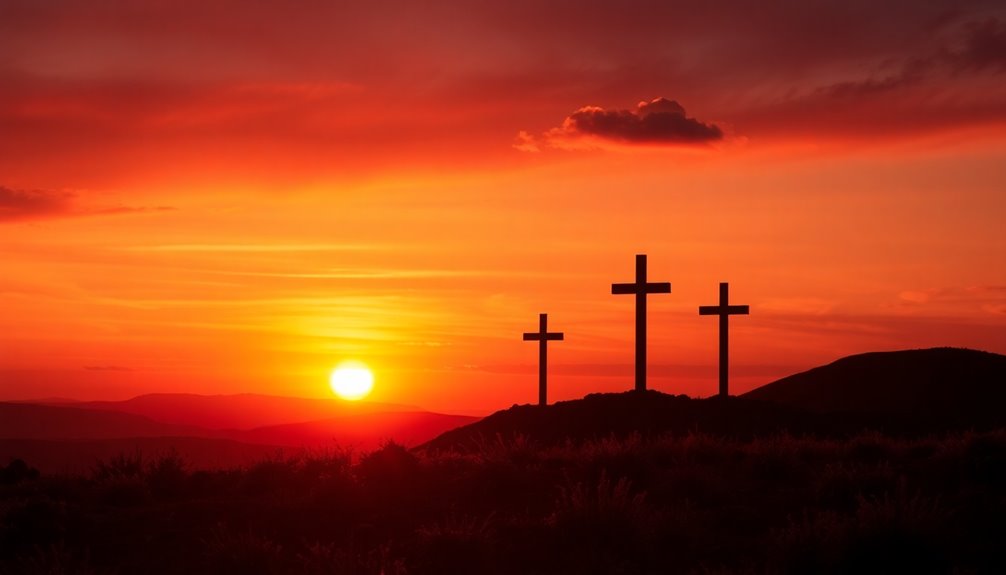
Understanding the day Jesus died is crucial for grasping the significance of his crucifixion. Most scholars agree that Jesus was crucified on Friday, April 3, AD 33, which corresponds to Nisan 14 on the Jewish calendar. This day was also the Day of Preparation, as it preceded the Sabbath.
The Gospels recount that Jesus was led away for crucifixion around noon, with darkness enveloping the land until his death at approximately 3 PM. This timing is particularly poignant because it coincided with the Jewish Passover, a time when lambs were traditionally slaughtered. This reinforces Jesus' role as the sacrificial lamb, fulfilling deep-rooted theological symbolism.
The Last Supper, which took place the evening before, is often seen as a significant event leading up to his death, yet discrepancies among the Gospels regarding the timing of these events have sparked scholarly debates.
Despite these discussions, the consensus remains that Jesus' crucifixion on that fateful Friday holds immense importance in understanding the narrative of his death and its implications for believers.
Biblical Texts Supporting Crucifixion
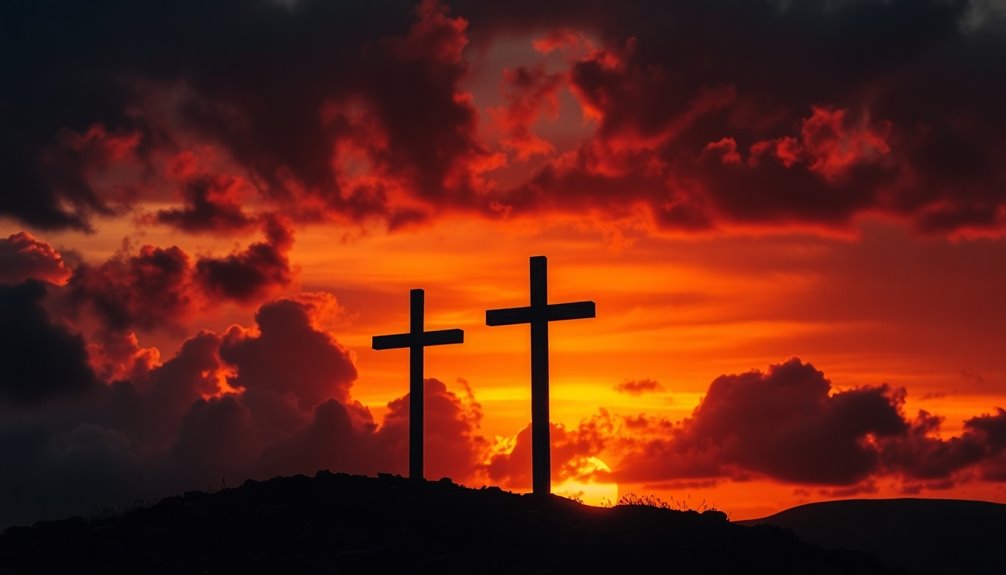
When exploring the biblical texts that support Jesus' crucifixion, you'll find strong evidence in the Gospels.
They consistently highlight key events, like the Last Supper and the timing of Jesus' death, which all point to a crucifixion on a Friday.
Primary Bible References
While the Gospels provide varying details, they all agree on the crucial fact that Jesus was crucified on a Friday, known as Preparation Day, right before the Sabbath (Matthew 27:62, Mark 15:42, Luke 23:54, John 19:14, 31).
The Synoptic Gospels—Matthew, Mark, and Luke—indicate that this event followed the Last Supper, which took place the evening before his death (Mark 14:12-26, Luke 22:14-20).
John's Gospel, however, presents a different timeline, suggesting that Jesus was crucified on the eve of Passover, just prior to the festival's commencement (John 19:14). This timing is significant, as it aligns Jesus' crucifixion with the Jewish observance of Passover, symbolizing him as the Passover lamb (1 Corinthians 5:7).
Notably, Mark 15:34 details a three-hour period of darkness from noon until 3 PM, leading to Jesus' death at the ninth hour.
This sequence of events underscores the theological implications of Jesus' crucifixion occurring on Preparation Day, setting the stage for the profound meaning of sacrifice and redemption in the context of the Sabbath and Passover.
Secondary Bible References
Various biblical texts further illuminate the significance of Jesus' crucifixion, providing insights that support the accounts found in the Gospels. The synoptic gospels consistently indicate that Jesus was crucified on a Friday, known as Preparation Day, just before the Sabbath (Mark 15:42, Luke 23:54, John 19:14). John 19:14 notes that Jesus was condemned around the sixth hour, while Mark 15:25 mentions the third hour, highlighting the differing timelines of His crucifixion.
As you read Matthew 27:46, you'll notice the profound weight of Jesus' last words, underscoring His sacrifice on the cross. Additionally, Luke 23:45 describes an extraordinary event where darkness enveloped the land from noon until 3 p.m., coinciding with the moment of His death. This darkness emphasizes the gravity of what was happening.
The crucifixion also connects deeply to the Jewish Passover, as John 1:29 identifies Jesus as the "Lamb of God," paralleling the sacrificial lambs offered during this pivotal festival. This intricate tapestry of scripture reinforces the significance of Jesus' death, paving the way for the resurrection and fulfilling the ultimate sacrifice for humanity.
Jewish Passover Significance

The Jewish Passover holds profound significance as it commemorates the Israelites' exodus from Egypt, symbolizing liberation and divine redemption. Celebrated on the 14th day of Nisan, this festival includes the ritual sacrifice of a lamb, which represents deliverance from bondage. During Passover, you consume unleavened bread, a reminder of the haste with which the Israelites left Egypt, having no time to let their bread rise.
The significance of the Passover lamb is deeply rooted in Jewish law, requiring that no bones be broken during its preparation. This detail parallels the crucifixion of Jesus, who's referred to as the "Lamb of God."
The Last Supper, often identified as a Passover meal in the Synoptic Gospels, occurred shortly before Jesus' crucifixion, linking his death to the Passover's themes of sacrifice and redemption.
Passover serves not only as a pivotal event in the Jewish calendar but also foreshadows Jesus' sacrificial role in Christian theology. His death aligns with the timing of the Passover lamb's slaughter, offering a powerful connection between the two faiths and emphasizing the profound themes of sacrifice and redemption inherent in both traditions.
Cultural Context of Crucifixion

Understanding the cultural context of Jesus' crucifixion sheds light on its profound implications. The event took place on the Day of Preparation, which corresponded with Nisan 14 in the Jewish calendar, right before the Passover feast. This timing was significant, as thousands of lambs were sacrificed in the temple during this period, symbolizing the Jewish tradition of atonement. Jesus was seen as the ultimate sacrificial lamb, further emphasizing the deep theological connections of his death.
The Sanhedrin, comprising the high priests and elders, conducted Jesus' trial under questionable circumstances since Jewish tradition prohibited capital cases during holy days. This raises important questions about the legality of their verdict.
His crucifixion coincided with the onset of the Sabbath and the Passover celebrations, creating a backdrop of intense cultural and religious significance.
As you reflect on these events, consider how they intertwine with the Jewish identity and beliefs of that time. The crucifixion wasn't just a solitary event; it resonated deeply within the framework of their faith, marking a pivotal moment in history that would redefine concepts of sacrifice and redemption.
Misunderstandings About Good Friday

When you think about Good Friday, it's easy to get mixed up about its significance and timing.
Many people assume it's just a joyful holiday, but it actually marks a day of deep sorrow and sacrifice.
Additionally, differing calendar interpretations can complicate the understanding of when Jesus truly died, leading to further confusion.
Debunk Good Friday Misconceptions
Many people hold misconceptions about Good Friday, often confusing its significance and timeline. While it's widely believed that Jesus was crucified on Friday, Nisan 14, aligning with the Jewish Passover, some interpretations suggest he might've been crucified on Thursday.
The Synoptic Gospels—Matthew, Mark, and Luke—depict the Last Supper as a Passover meal occurring on Thursday, which adds to the confusion. In contrast, the Gospel of John implies that Jesus' crucifixion happened before Passover.
This discrepancy raises questions about the exact timeline of events. However, what's crucial on Good Friday is understanding that Jesus' death was an atoning sacrifice for humanity's sins. His crucifixion at the ninth hour (3 PM) holds special significance, coinciding with the traditional slaughtering of the Passover lambs at the Temple.
Despite the varying accounts of when Jesus was crucified, the core message of Good Friday remains steadfast: it symbolizes not only his sacrificial death but also the promise of resurrection. By debunking these misconceptions, you can better appreciate the true meaning behind this solemn day.
Different Calendar Interpretations
Confusion often arises around the calendar interpretations of Good Friday, primarily due to the differing accounts in the Gospels. The Synoptic Gospels present the Last Supper as a Passover meal, suggesting Jesus was crucified shortly after the feast. However, John's account implies that the Last Supper occurred before Passover, leading to conflicting timelines about Jesus' crucifixion.
According to the Gospels, Jesus was crucified on the Day of Preparation, which corresponds to Friday, Nisan 14 in the Jewish calendar. This day precedes the Sabbath, when no preparation work could be done. Since the Jewish calendar measures days from sunset to sunset, the implications of this timing can be profound.
Good Friday, traditionally observed as the day of Jesus' death, aligns with this practice of preparing for the Sabbath.
Despite early Christian writings and the establishment of Easter celebrations solidifying Good Friday's observance, historical uncertainties linger regarding the exact date of Jesus' crucifixion.
These differing interpretations can complicate our understanding of the events surrounding this pivotal moment in history. Understanding these nuances helps clarify the significance of Good Friday in the Christian tradition.
Faith-Based Community Gatherings
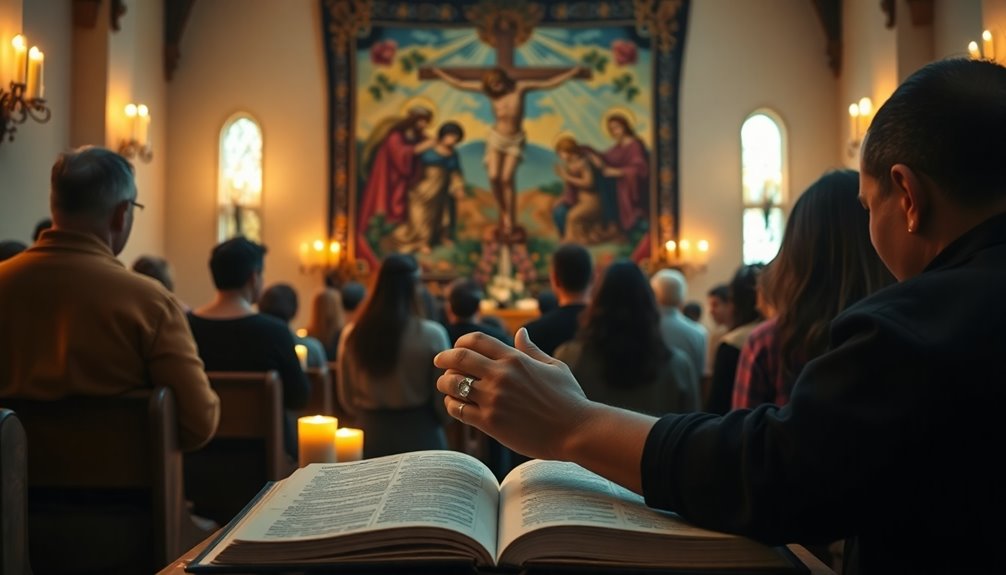
When you gather with your faith community, it's a powerful opportunity to reflect on personal sacrifice and what it means in your own life.
These gatherings encourage group reflection, allowing you to explore how Jesus' death impacts your beliefs and values.
Together, you can share insights that deepen your understanding of sacrifice and its significance in your spiritual journey.
Reflect on Personal Sacrifice
Personal sacrifice is at the heart of faith-based community gatherings, where believers come together to reflect on the profound implications of Jesus' crucifixion. This pivotal event, occurring on Nisan 14 during Passover, emphasizes themes of sacrifice and redemption.
As you gather with others, consider the significance of Jesus being the "Lamb of God," paralleling the sacrificial lambs traditionally offered during this holy time.
The Last Supper serves as a reminder of the importance of community in remembering Jesus' ultimate sacrifice. During these gatherings, you can explore how the tearing of the temple curtain at His death symbolizes the removal of barriers between humanity and God, offering spiritual access to all believers.
This act encourages you to reflect on the transformative power of personal sacrifice in your own life.
Furthermore, the resurrection following Jesus' death reinforces the hope and renewal that sacrifices can bring. As you engage in these community discussions, you deepen your understanding of how personal sacrifices impact your spiritual journey and those around you.
Embrace the opportunity to grow together, celebrating the redemptive power of faith and the lasting effects of Jesus' love.
Group Reflection on Sacrifice
Gathering as a community to reflect on sacrifice can deepen your understanding of its significance in your faith journey. When you come together to discuss Jesus' crucifixion, you explore the profound implications of his sacrifice as the Lamb of God. This aligns with the Jewish Passover, where lambs were sacrificed for atonement, illustrating the depth of Jesus' role in your redemption.
As you reflect, consider the timing of Jesus' death at 3 PM, the ninth hour, a moment echoed in all four Gospels. This shared remembrance underscores not just his suffering but also the mercy extended to humanity through his selflessness.
During these gatherings, you might discuss how the tearing of the temple curtain and the resurrection of saints symbolize the fulfillment of Old Testament prophecies and the new covenant established through Christ.
Ultimately, these community reflections inspire you to embody Jesus' teachings, embracing themes of redemption and selflessness in your daily life. By sharing insights and experiences, you cultivate a deeper appreciation for the sacrifice that forms the cornerstone of your faith, reminding you of the transformative power of love and grace.
Good Friday's Historical Significance
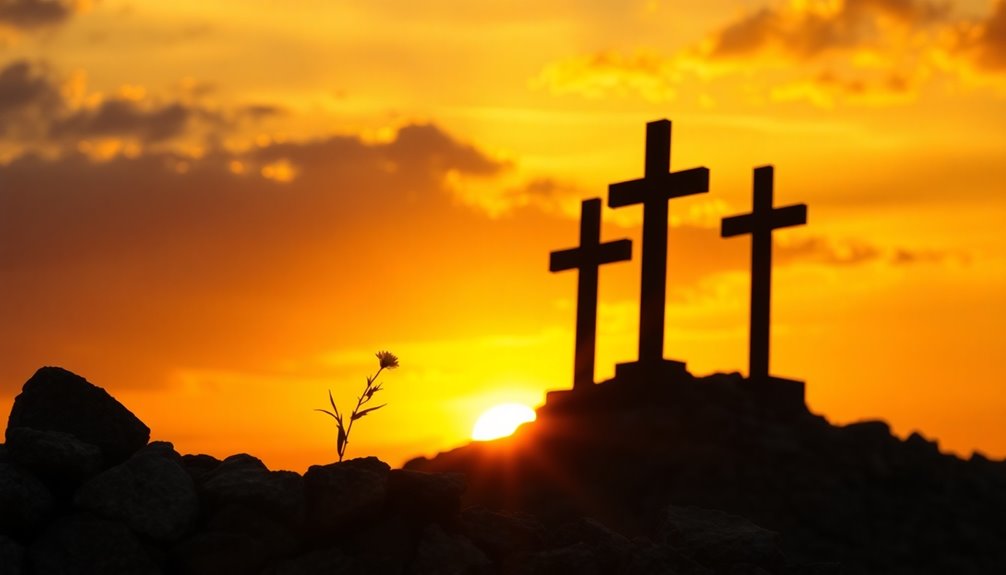
Good Friday holds profound historical significance as it marks the day Christians believe Jesus was crucified, an event that reshaped religious understanding. Traditionally observed on the Friday before Easter Sunday, this day is estimated to be April 3, AD 33, aligning with Nisan 14 in the Jewish calendar and coinciding with Passover.
The crucifixion happened on Preparation Day, just before the Sabbath, highlighting the connection between Jesus' death and the sacrificial lambs offered during Passover.
This day commemorates the fulfillment of Old Testament prophecies, emphasizing Jesus' role as the sacrificial lamb, as noted in 1 Corinthians 5:7. His death on Good Friday serves a pivotal purpose in Christian theology, symbolizing atonement for sins and offering redemption to believers.
By understanding the historical significance of this day, you can appreciate the depth of its meaning within the Christian faith. Good Friday isn't just a remembrance of Jesus' death; it's a cornerstone of belief that underscores the importance of sacrifice, love, and hope for salvation.
Reflecting on this day invites you to contemplate the profound implications of Jesus' crucifixion in your spiritual journey.
Additional Resources

For those looking to deepen their understanding of Jesus' crucifixion and its significance, a variety of resources are available.
You can explore the historical context surrounding Friday, April 3, AD 33, when Jesus is believed to have died on Nisan 14, which aligns with Passover. The Synoptic Gospels provide insights into the events leading up to the crucifixion, including the Last Supper, which was traditionally a Passover meal.
Consider studying astronomical calculations that highlight how lunar eclipses might support this date, as they coincide with prophetic references to the darkness that enveloped the land during Jesus' final hours.
Books and scholarly articles discussing these astronomical events can enhance your understanding of the timeline.
Moreover, delve into theological discussions about the significance of Jesus' crucifixion and resurrection. You'll find that these events symbolize redemption and fulfillment of Old Testament prophecies, offering a profound perspective on their importance in Christian faith.
Documentaries and lectures can also provide visual and narrative context, helping you grasp the depth of these pivotal moments in history.
Frequently Asked Questions
What Date Exactly Did Jesus Die?
You might find that the exact date of Jesus' death has been a topic of much debate among scholars.
Many believe it occurred on April 3, AD 33, aligning with significant events like the Passover.
Historical and astronomical evidence supports this date, including a partial lunar eclipse that coincided with it.
While some argue for different dates, the consensus tends to point toward this date as the most likely time of his crucifixion.
Did Jesus Die on Good Friday?
Yes, Jesus died on Good Friday, a day commemorated by Christians as the time of his crucifixion.
This observance holds deep significance, symbolizing Jesus as the paschal lamb linked to Passover.
You'll find that the early Christian church established this tradition, emphasizing reflection and mourning over his sacrifice.
The Gospels indicate that he died around 3 PM, further solidifying Good Friday's importance in the Christian calendar.
What Day of the Holy Week Did Jesus Die?
During Holy Week, you'll find that Jesus died on Good Friday. This day is significant as it marks the culmination of the events leading up to his crucifixion.
Observing the timeline, you can see that it occurs just before the Sabbath, during Passover. The Last Supper happened the evening prior, setting the stage for the crucifixion, which is believed to have occurred around noon, with Jesus breathing his last around 3 PM.
Why Did Jesus Die on Wednesday?
You might consider that Jesus died on Wednesday to align with the Jewish Passover, emphasizing the significance of his sacrifice.
Advocates argue this timing allows for a clear three-day count until the resurrection, fitting Gospel narratives more neatly.
By separating the Passover Sabbath from the weekly Sabbath, it highlights the events leading to his resurrection without confusion.
This perspective aims to resolve discrepancies in the accounts, providing a more coherent timeline.

